Surface Chlorophyll-A Fronts in the Yellow and Bohai Seas Based on Satellite Data
Abstract
:1. Introduction
2. Materials and Methods
2.1. Chl-a and SST Satellite Data
2.2. Front Detection
3. Results
3.1. Satellite-Derived Monthly Chl-a Pattern
3.2. Chl-a Fronts and Their Seasonal Variation
3.3. SST Fronts and Their Seasonal Variation
4. Discussion
4.1. Interpretation of Signatures of the Chl-a Fronts Based on Physical Oceanography
4.2. Relationship between Chl-a Fronts and SST Fronts
4.3. Implication from the Chl-a Front
5. Conclusions
Author Contributions
Funding
Institutional Review Board Statement
Informed Consent Statement
Data Availability Statement
Acknowledgments
Conflicts of Interest
References
- Cushman-Roisin, B.; Beckers, J.M. Introduction to Geophysical Fluid Dynamics: Physical and Numerical Aspects; Academic Press: Cambridge, MA, USA, 2011. [Google Scholar]
- Belkin, I.M.; O’Reilly, J.E. An algorithm for oceanic front detection in chlorophyll and SST satellite imagery. J. Marine. Syst. 2009, 78, 319–326. [Google Scholar] [CrossRef]
- Acha, E.M.; Piola, A.; Iribarne, O.; Mianzan, H. Ecological Processes at Marine Fronts; Springerbriefs in Environmental Science: Basingstoke, UK, 2015. [Google Scholar]
- Muñoz, M.; Reul, A.; García-Martínez, M.; Plaza, F.; Bautista, B.; Moya, F.; Vargas-Yáñez, M. Oceanographic and Bathymetric Features as the Target for Pelagic MPA Design: A Case Study on the Cape of Gata. Water 2018, 20, 1043. [Google Scholar] [CrossRef] [Green Version]
- Zhang, Y.; Li, D.; Wang, K.; Xue, B. Contribution of Biological Effects to the Carbon Sources/Sinks and the Trophic Status of the Ecosystem in the Changjiang (Yangtze) River Estuary Plume in Summer as Indicated by Net Ecosystem Production Variations. Water 2019, 6, 1264. [Google Scholar] [CrossRef] [Green Version]
- Hickox, R.; Belkin, I.; Cornillon, P.; Shan, Z. Climatology and seasonal variability of ocean fronts in the East China, Yellow and Bohai seas from satellite SST data. Geophys. Res. Lett. 2000, 27, 2945–2948. [Google Scholar] [CrossRef] [Green Version]
- Vazquez-Cuervo, J.; Dewitte, B.; Chin, T.M.; Armstrong, E.M.; Purca, S.; Alburqueque, E. An analysis of SST gradients off the Peruvian Coast: The impact of going to higher resolution. Remote. Sens. Environ. 2013, 131, 76–84. [Google Scholar] [CrossRef]
- O’Reilly, J.E.; Maritorena, S.; Mitchell, B.G.; Seigal, D.; Carder, K.; Garver, S.; Kahru, M.; McClain, C. Ocean color chlorophyll algorithms for SeaWiFS. J. Geophys. Res. 1998, 103, 24937–24954. [Google Scholar] [CrossRef] [Green Version]
- Mercado, J.; León, P.; Salles, S.; Cortés, D.; Yebra, L.; Gómez-Jakobsen, F.; Herrera, I.; Alonso, A.; Sánchez, A.; Valcárcel-Pérez, N.; et al. Time Variability Patterns of Eutrophication Indicators in the Bay of Algeciras (South Spain). Water 2018, 7, 938. [Google Scholar] [CrossRef] [Green Version]
- Shi, L.; Mao, Z.; Wu, J.; Liu, M.; Zhang, Y.; Wang, Z. Variations in spectral absorption properties of phytoplankton, non-algal particles and chromophoric dissolved organic matter in Lake Qiandaohu. Water 2017, 5, 352. [Google Scholar] [CrossRef] [Green Version]
- Polovina, J.J.; Howell, E.; Kobayashi, D.R.; Seki, M.P. The Transition Zone Chlorophyll Front, a dynamic global feature defining migration and forage habitat for marine resources. Prog. Oceanogr. 2001, 49, 469–483. [Google Scholar] [CrossRef]
- Legeckis, R.; Brown, C.W.; Chang, P.S. Geostationary satellites reveal motions of ocean surface fronts. J. Mar. Syst. 2002, 37, 3–15. [Google Scholar] [CrossRef]
- Hu, J.Y.; Kawamura, H.; Tang, D.L. Tidal front around the Hainan Island, northwest of the South China Sea. J. Geophys. Res. Oceans 2003, 108, 3342. [Google Scholar] [CrossRef]
- Stegmann, P.M.; Ullman, D.S. Variability in chlorophyll and sea surface temperature fronts in the Long Island Sound outflow region from satellite observations. J. Geophys. Res. Oceans 2004, 109, C3S–C7S. [Google Scholar] [CrossRef] [Green Version]
- Liu, Z.; Wang, H.; Guo, X.; Qiang, W.; Gao, H. The age of Yellow River water in the Bohai Sea. J. Geophys. Res. Oceans 2012, 117, 317–323. [Google Scholar] [CrossRef] [Green Version]
- Guo, W.; Wu, G.; Liang, B.; Xu, T.; Chen, X.; Yang, Z.; Xie, M.; Jiang, M. The influence of surface wave on water exchange in the Bohai Sea. Cont. Shelf Res. 2016, 118, 128–142. [Google Scholar] [CrossRef]
- Huang, D.; Tao, Z.; Feng, Z. Sea-surface temperature fronts in the Yellow and East China Seas from TRMM microwave imager data. Deep Sea Res. Part II Top. Stud. Oceanogr. 2010, 57, 1024. [Google Scholar] [CrossRef]
- Su, J. A review of circulation dynamics of the China coastal seas. Acta Oceanol. Sin. 2001, 4, 1–16. [Google Scholar]
- Zhang, S.W.; Wang, Q.Y.; Lü, Y.; Cui, H.; Yuan, Y.L. Observation of the seasonal evolution of the Yellow Sea Cold Water Mass in 1996–1998. Cont. Shelf Res. 2008, 28, 457. [Google Scholar] [CrossRef]
- Xia, C.; Qiao, F.; Yang, Y.; Ma, J.; Yuan, Y. Three-dimensional structure of the summertime circulation in the Yellow Sea from a wave-tide-circulation coupled model. J. Geophys. Res. Oceans 2006, 111, 1–19. [Google Scholar] [CrossRef]
- Jiang, W.; Thomas, P.; Jun, S.; Andreas, S. SPM transport in the Bohai Sea: Field experiments and numerical modelling. J. Mar. Syst. 2004, 44, 175–188. [Google Scholar] [CrossRef]
- Liu, S.M.; Zhang, J.; Chen, S.Z.; Chen, H.T.; Hong, G.H.; Wei, H.; Wu, Q.M. Inventory of nutrient compounds in the Yellow Sea. Cont. Shelf Res. 2003, 23, 1161–1174. [Google Scholar] [CrossRef]
- Liu, S.M.; Li, L.W.; Zhang, Z. Inventory of nutrients in the Bohai. Cont. Shelf Res. 2011, 31, 1797. [Google Scholar]
- Son, S.H.; Kim, Y.H.; Kwon, J.; Kim, H.; Park, K. Characterization of spatial and temporal variation of suspended sediments in the Yellow and East China Seas using satellite ocean color data. Mapping GlSci. Remote Sens. 2014, 51, 212–226. [Google Scholar] [CrossRef]
- Bian, C.; Jiang, W.; Quan, Q.; Wang, T.; Greatbatch, R.J.; Li, W. Distributions of suspended sediment concentration in the Yellow Sea and the East China Sea based on field surveys during the four seasons of 2011. J. Mar. Syst. 2013, 121–122, 24–35. [Google Scholar] [CrossRef]
- Liu, F.; Su, J.; Moll, A.; Krasemann, H.; Chen, X.; Pohlmann, T.; Wirtz, K. Assessment of the summer-autumn bloom in the Bohai Sea using satellite images to identify the roles of wind mixing and light conditions. J. Mar. Syst. 2014, 129, 303–317. [Google Scholar] [CrossRef] [Green Version]
- Fan, W.; Chuanyu, L.; Qingjia, M. Effect of the Yellow Sea warm current fronts on the westward shift of the Yellow Sea warm tongue in winter. Cont. Shelf Res. 2012, 45, 98–107. [Google Scholar]
- Lin, L.; Liu, D.; Luo, C.; Xie, L. Double fronts in the Yellow Sea in summertime identified using sea surface temperature data of multi-scale ultra-high resolution analysis. Cont. Shelf Res. 2019, 175, 76–86. [Google Scholar] [CrossRef]
- Lee, M.; Chang, Y.; Shimada, T. Seasonal evolution of fine-scale sea surface temperature fronts in the East China Sea. Deep Sea Res. Part II Top. Stud. Oceanogr. 2015, 119, 20–29. [Google Scholar] [CrossRef]
- Wang, Y.; Liu, D.; Tang, D.L. Application of a generalized additive model (GAM) for estimating chlorophyll-a concentration from MODIS data in the Bohai and Yellow Seas. China. Int. J. Remote Sens. 2017, 3, 639–661. [Google Scholar] [CrossRef]
- Karimova, S. Hydrological fronts seen in visible and infrared MODIS imagery of the Black Sea. Int. J. Remote Sens. 2014, 16, 6113–6134. [Google Scholar] [CrossRef]
- Lin, L.; Wang, Y.; Liu, D. Vertical average irradiance shapes the spatial pattern of winter chlorophyll-a in the Yellow Sea. Estuar. Coast. Shelf Sci. 2019, 224, 11–19. [Google Scholar] [CrossRef]
- Zeng, X.; Belkin, I.M.; Peng, S.; Li, Y. East Hainan upwelling fronts detected by remote sensing and modelled in summer. Int. J. Remote Sens. 2014, 11–12, 4441–4451. [Google Scholar] [CrossRef]
- Fu, M.; Zongling, W.; Yan, L.; Ruixiang, L.; Ping, S.; Xiuhua, W.; Xuezheng, L.; Jingsong, G. Phytoplankton biomass size structure and its regulation in the Southern Yellow Sea (China): Seasonal variability. Cont. Shelf Res. 2009, 29, 2194. [Google Scholar] [CrossRef]
- Shi, J.; Liu, Y.; Mao, X.; Guo, X.; Wei, H.; Gao, H. Interannual variation of spring phytoplankton bloom and response to turbulent energy generated by atmospheric forcing in the central Southern Yellow Sea of China: Satellite observations and numerical model study. Cont. Shelf Res. 2016, S176438184. [Google Scholar] [CrossRef]
- Liu, D.; Wang, Y. Trends of satellite derived chlorophyll-a (1997–2011) in the Bohai and Yellow Seas, China: Effects of bathymetry on seasonal and inter-annual patterns. Prog. Oceanogr. 2013, 116, 154–166. [Google Scholar] [CrossRef]
- Xu, Y.; Ishizaka, J.; Yamaguchi, H.; Siswanto, E.; Wang, S. Relationships of interannual variability in SST and phytoplankton blooms with giant jellyfish (Nemopilema nomurai) outbreaks in the Yellow Sea and East China Sea. J. Oceanogr. 2013, 69, 511–526. [Google Scholar] [CrossRef] [Green Version]
- Lü, X.; Fangli, Q.; Changshui, X.; Guansuo, W.; Yeli, Y. Upwelling and surface cold patches in the Yellow Sea in summer: Effects of tidal mixing on the vertical circulation. Cont. Shelf Res. 2010, 30, 632. [Google Scholar] [CrossRef]
- Chen, C.T.A. Chemical and physical fronts in the Bohai, Yellow and East China seas. J. Mar. Syst. 2009, 78, 394–410. [Google Scholar] [CrossRef]
- Huang, D.; Fan, X.; Xu, D.; Tong, Y.; Su, J. Westward shift of the Yellow Sea warm salty tongue. Geophys. Res. Lett. 2005, 32, 348–362. [Google Scholar] [CrossRef]
- Shang, S.; Lee, Z.; Wei, G. Characterization of MODIS-derived euphotic zone depth: Results for the China Sea. Remote Sens. Environ. 2011, 115, 180–186. [Google Scholar] [CrossRef]
- Zhou, F.; Xuan, J.; Huang, D.; Liu, C.; Sun, J. The timing and the magnitude of spring phytoplankton blooms and their relationship with physical forcing in the central Yellow Sea in 2009. Deep Sea Res. Part II Top. Stud. Oceanogr. 2013, 97, 4–15. [Google Scholar] [CrossRef]
- Wei, Q.S.; Yu, Z.G.; Wang, B.D.; Fu, M.Z.; Xia, C.S.; Liu, L.; Zhan, R. Coupling of the spatial–temporal distributions of nutrients and physical conditions in the southern Yellow Sea. J. Mar. Syst. 2016, 156, 30–45. [Google Scholar] [CrossRef]
- Chen, C.; Jianrong, Z.; KiRyong, K.; Hedong, L.; Elise, R.; Sarah, A.G.; Judith, W.B. Cross-frontal transport along the Keweenaw coast in Lake Superior: A Lagrangian model study. Dyn. Atmos. Oceans 2002, 36, 102. [Google Scholar] [CrossRef]
- Munk, P. Differential growth of larval sprat Sprattus sprattus across a tidal front in the eastern North sea. Mar. Ecol. Prog. Ser. 1993, 1–2, 17–27. [Google Scholar] [CrossRef]
- Chu, P.C.; Fralick, C.R.; Haeger, S.D.; Carron, M.J. A parametric model for the Yellow Sea thermal variability. J. Geophys. Res. Oceans 1997, 102, 10499. [Google Scholar] [CrossRef] [Green Version]
- Qian, W.; Kang, H.-S.; Lee, D.-K. Distribution of seasonal rainfall in the East Asian monsoon region. Theor. Appl. Climatol. 2002, 73, 151–168. [Google Scholar] [CrossRef]
- Simpson, J.H.; Hunter, J.R. Fronts in the Irish Sea. Nature 1974, 250, 404–406. [Google Scholar] [CrossRef]
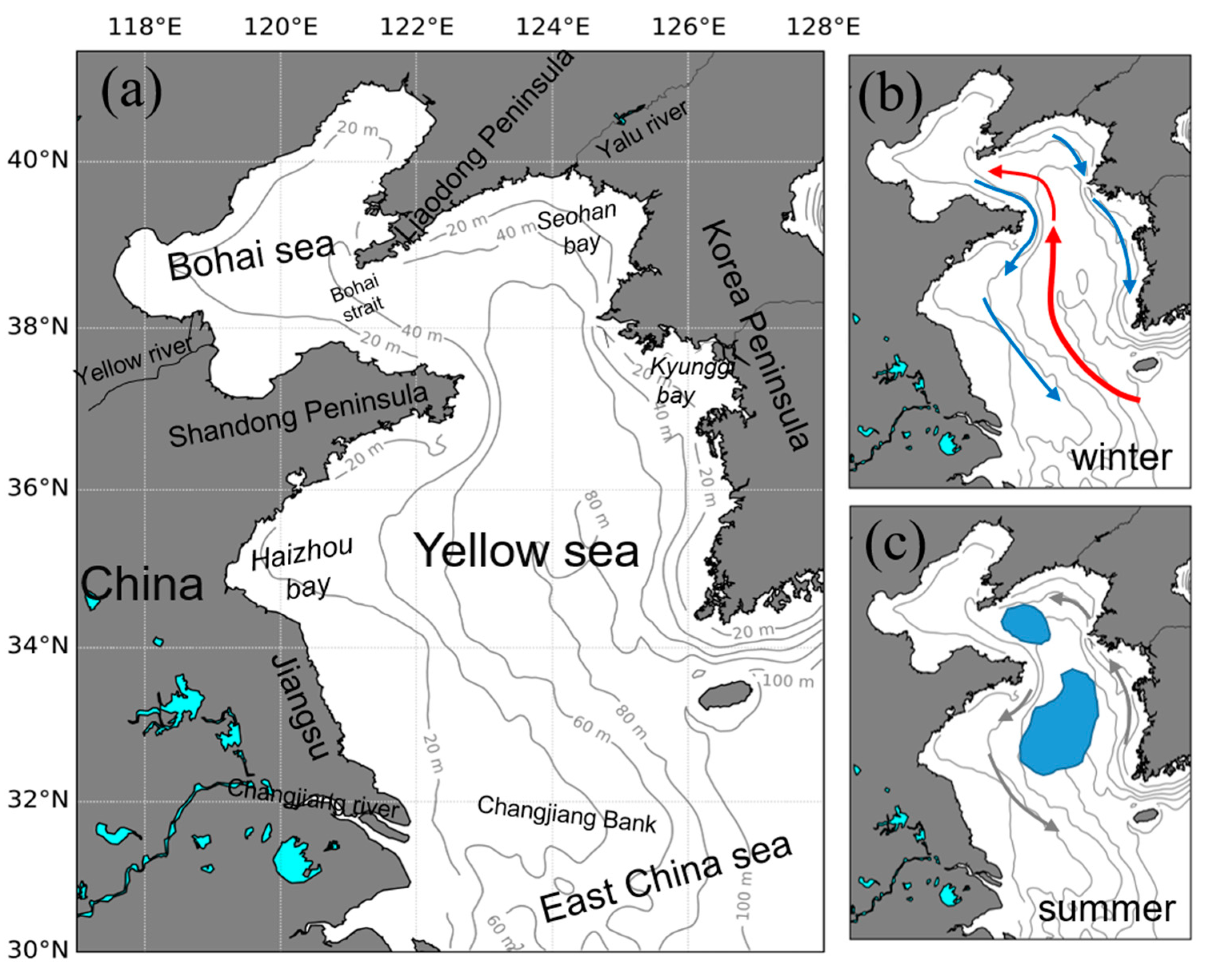
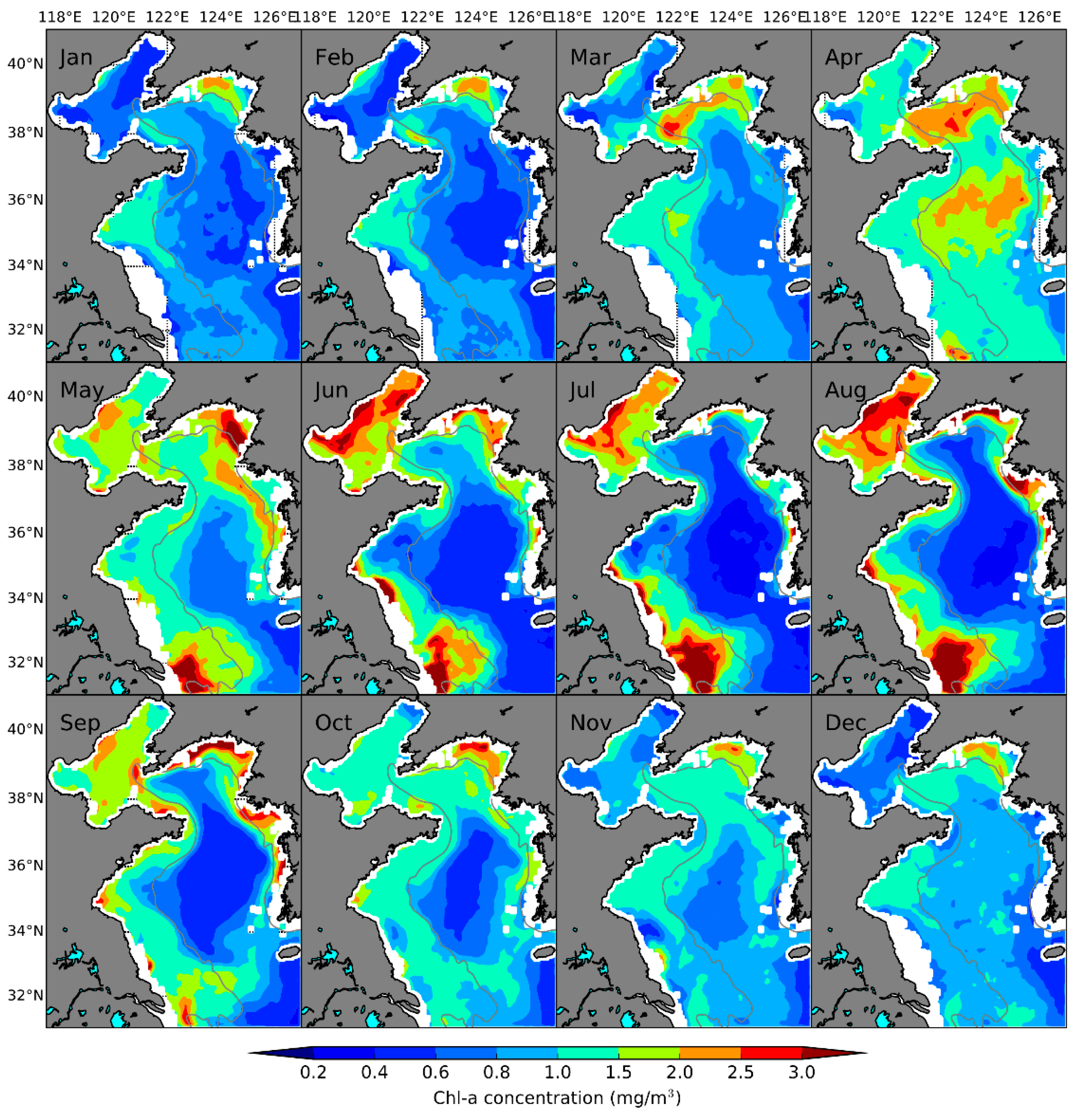

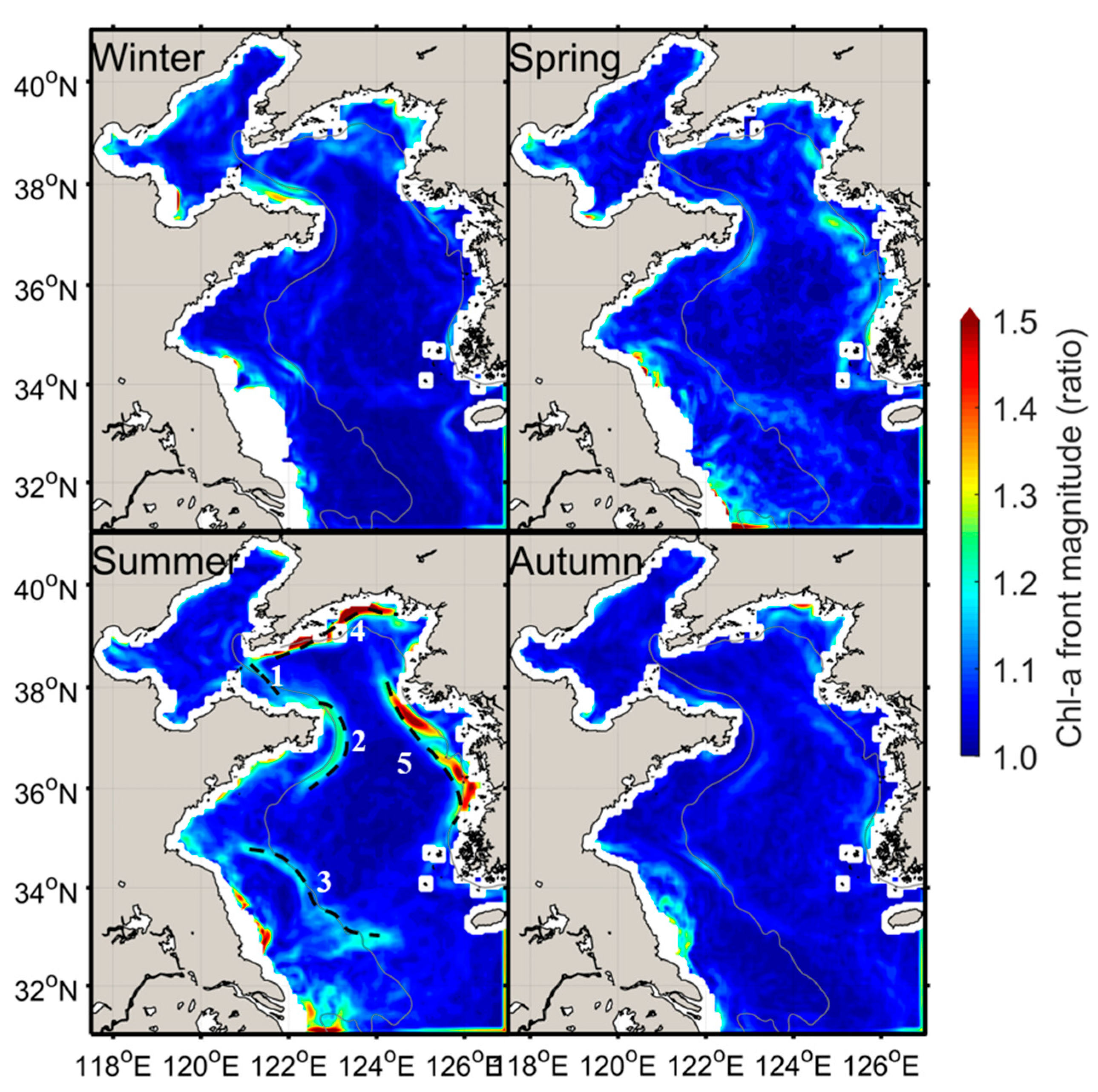
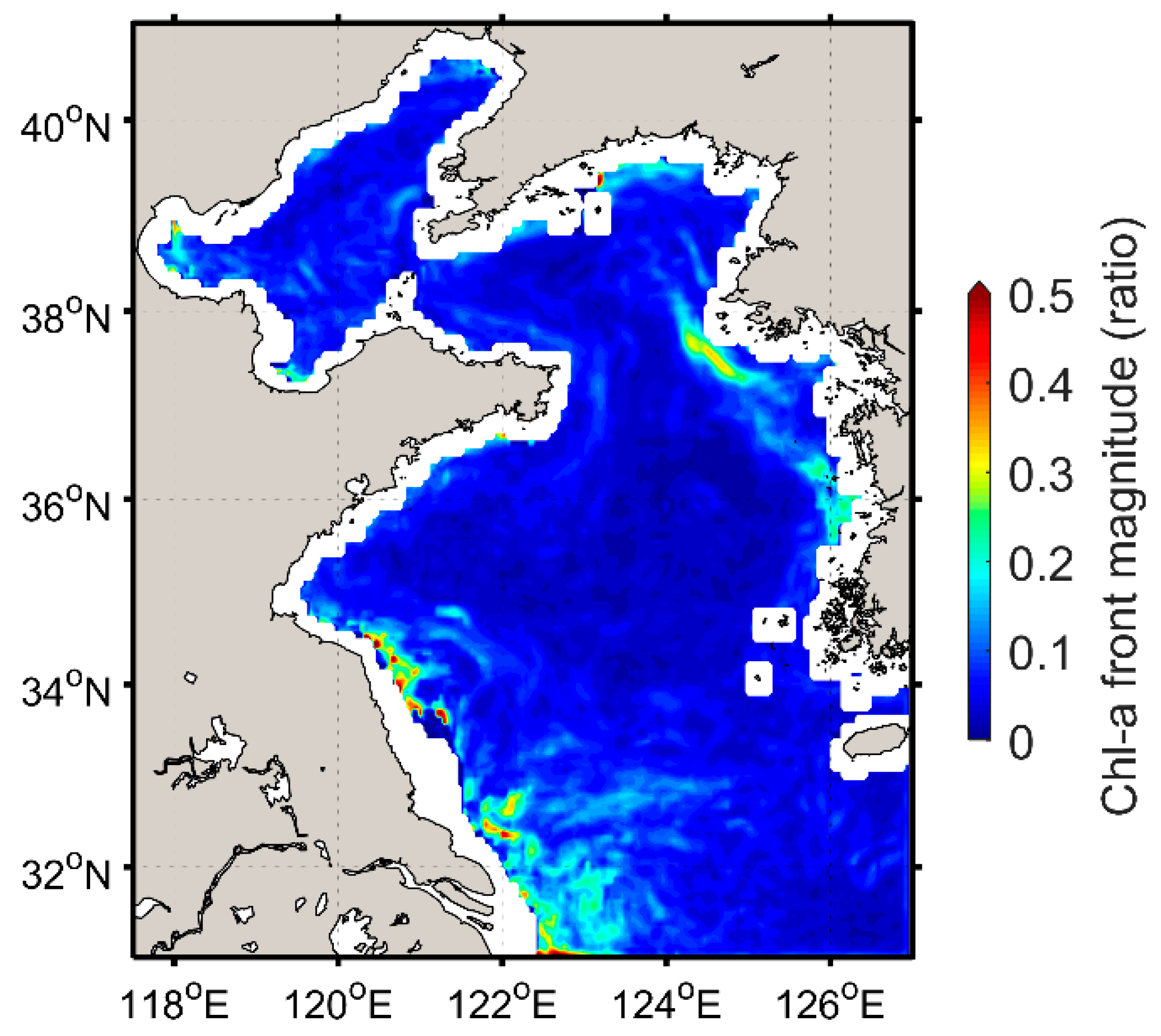
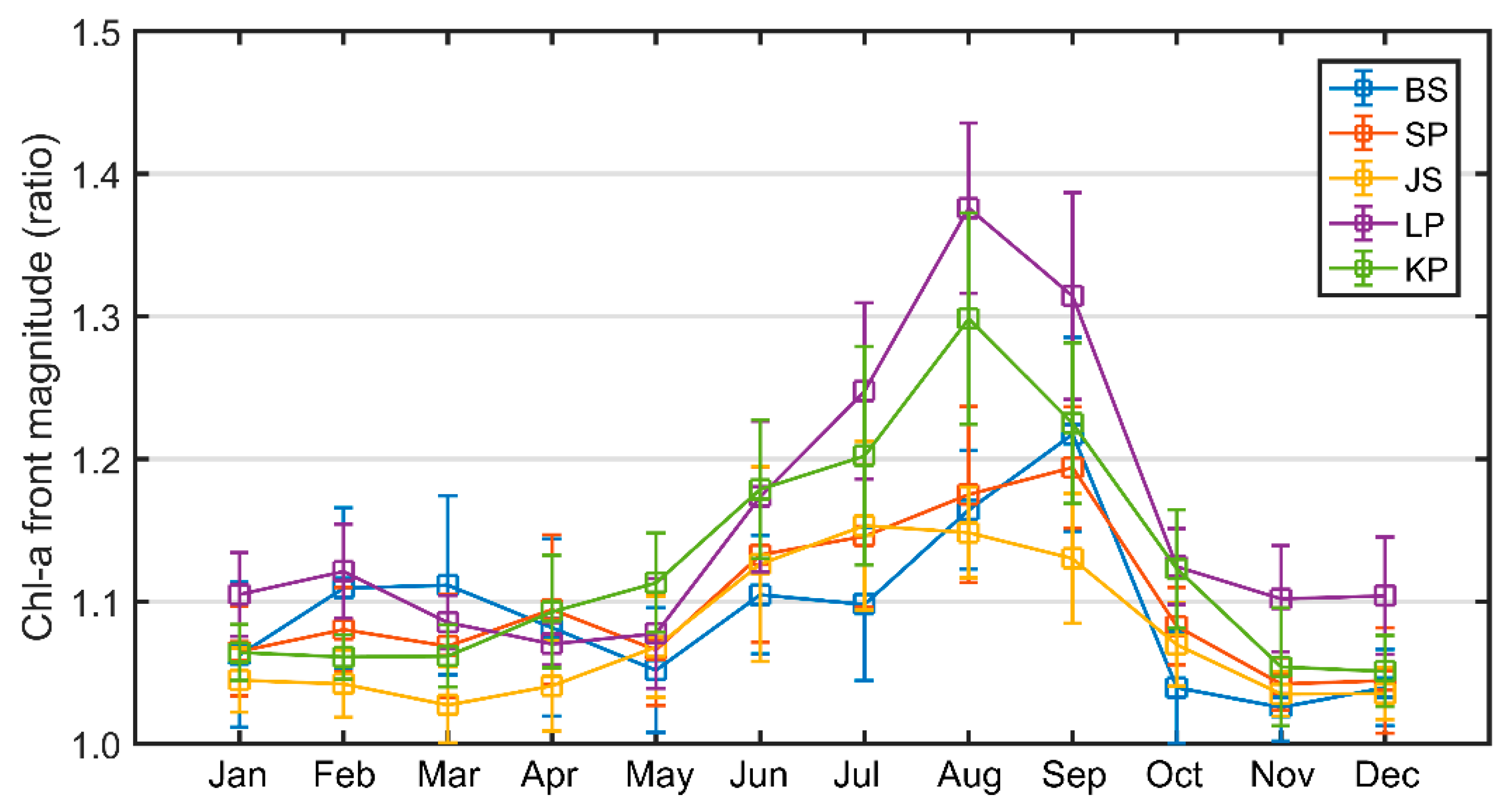
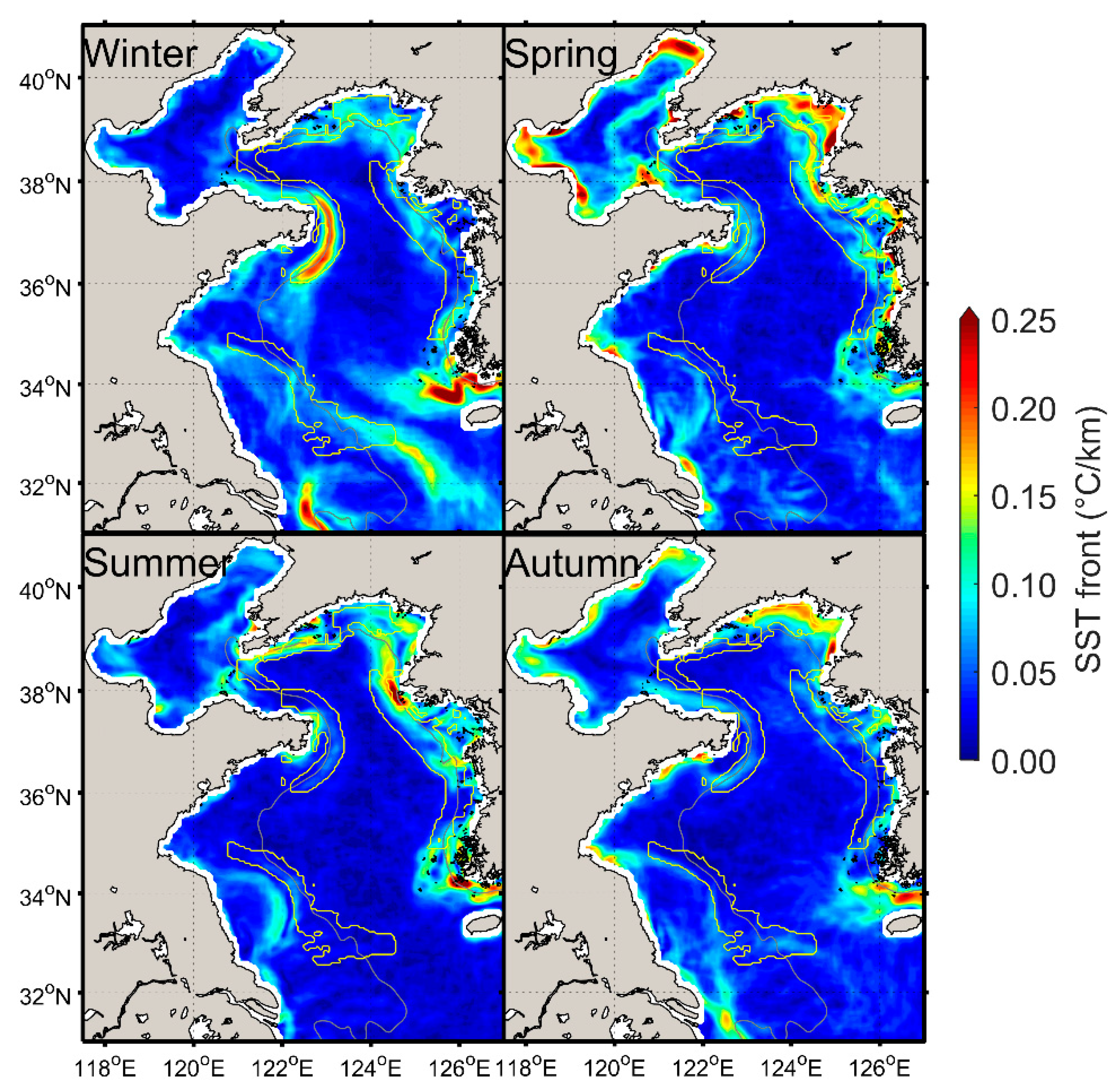

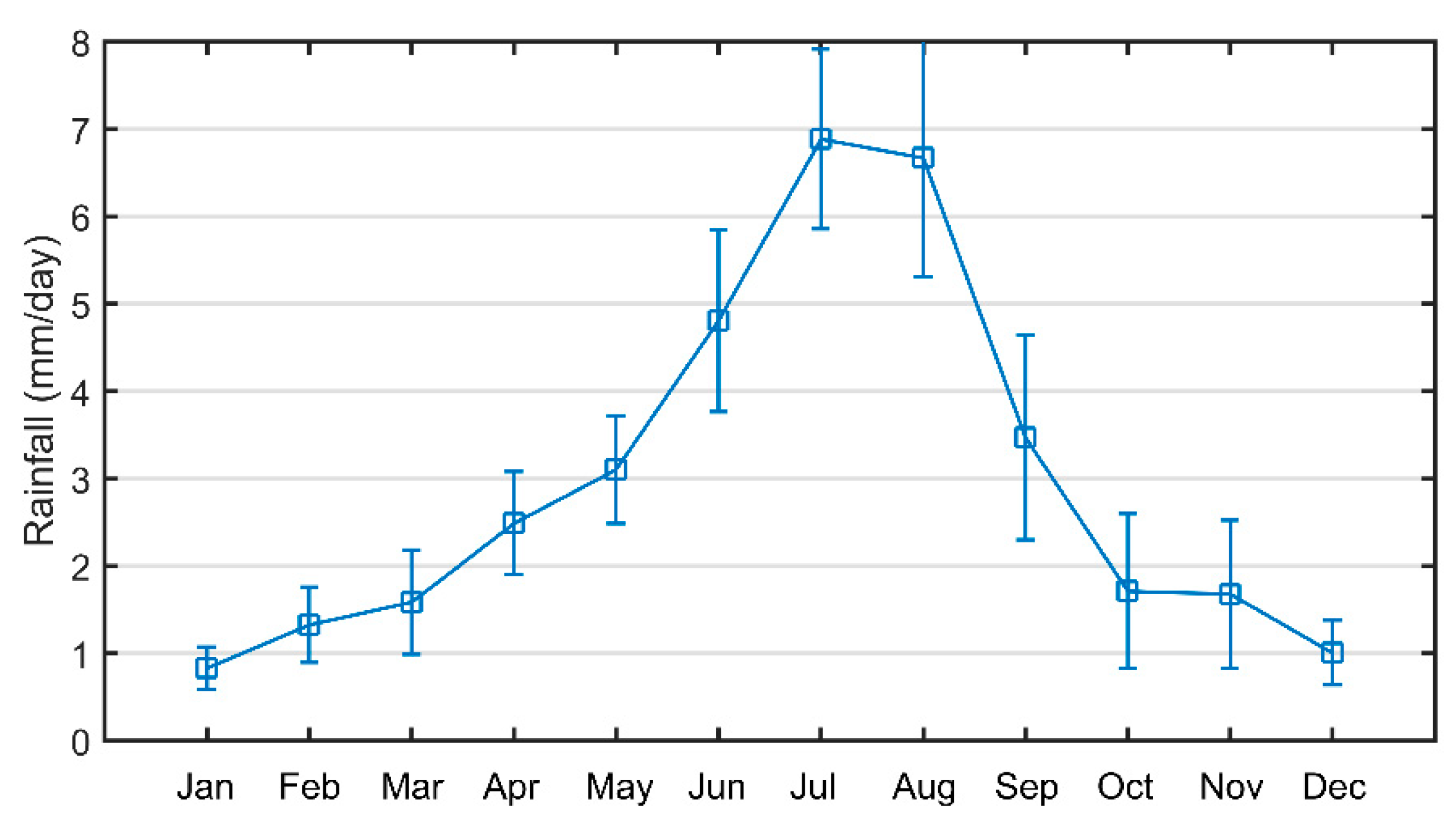

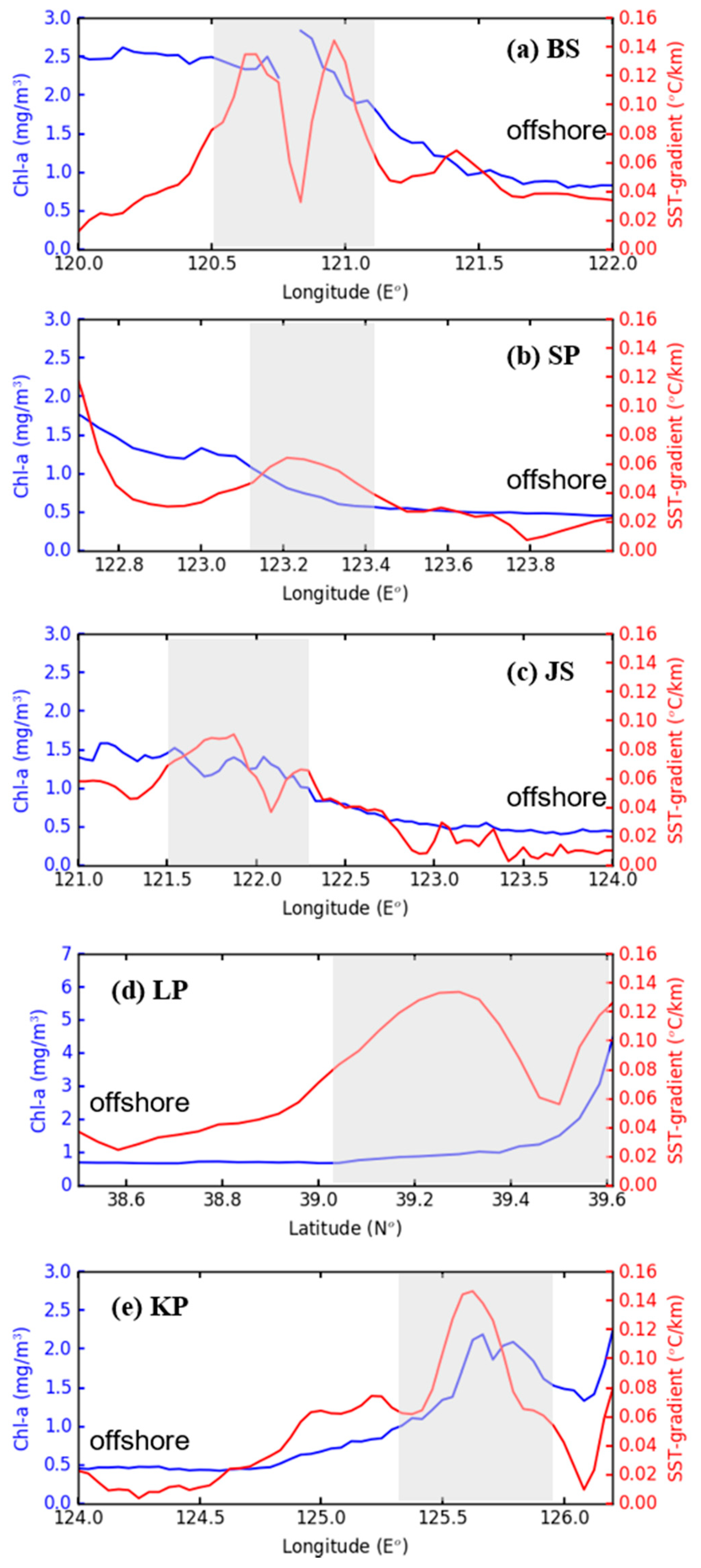
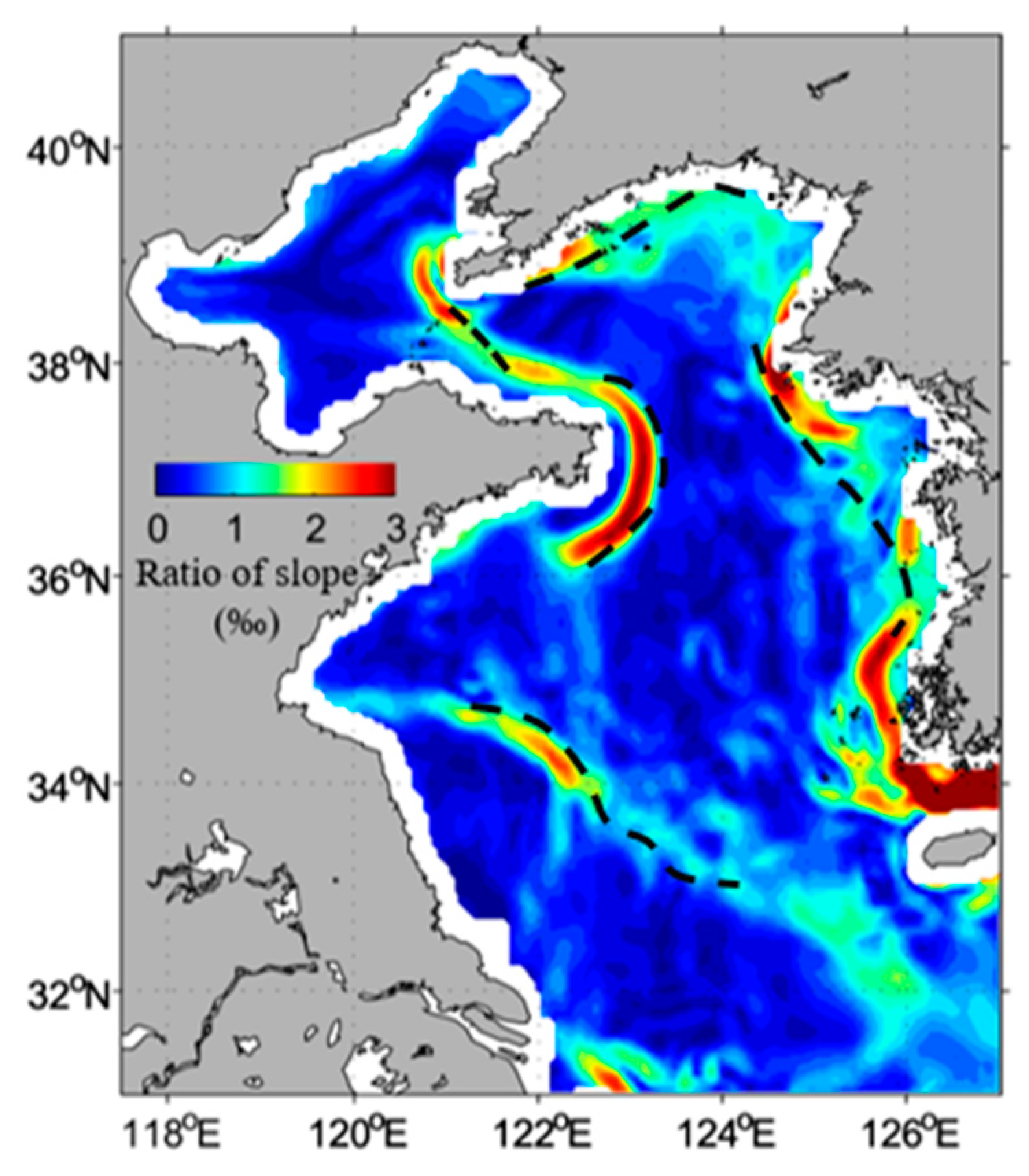
Publisher’s Note: MDPI stays neutral with regard to jurisdictional claims in published maps and institutional affiliations. |
© 2021 by the authors. Licensee MDPI, Basel, Switzerland. This article is an open access article distributed under the terms and conditions of the Creative Commons Attribution (CC BY) license (https://creativecommons.org/licenses/by/4.0/).
Share and Cite
Xia, L.; Liu, H.; Lin, L.; Wang, Y. Surface Chlorophyll-A Fronts in the Yellow and Bohai Seas Based on Satellite Data. J. Mar. Sci. Eng. 2021, 9, 1301. https://doi.org/10.3390/jmse9111301
Xia L, Liu H, Lin L, Wang Y. Surface Chlorophyll-A Fronts in the Yellow and Bohai Seas Based on Satellite Data. Journal of Marine Science and Engineering. 2021; 9(11):1301. https://doi.org/10.3390/jmse9111301
Chicago/Turabian StyleXia, Lu, Hao Liu, Lei Lin, and Yueqi Wang. 2021. "Surface Chlorophyll-A Fronts in the Yellow and Bohai Seas Based on Satellite Data" Journal of Marine Science and Engineering 9, no. 11: 1301. https://doi.org/10.3390/jmse9111301
APA StyleXia, L., Liu, H., Lin, L., & Wang, Y. (2021). Surface Chlorophyll-A Fronts in the Yellow and Bohai Seas Based on Satellite Data. Journal of Marine Science and Engineering, 9(11), 1301. https://doi.org/10.3390/jmse9111301





